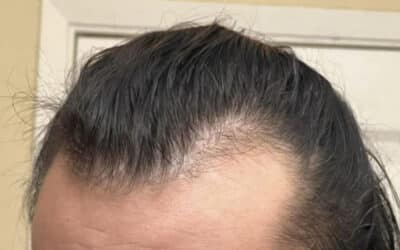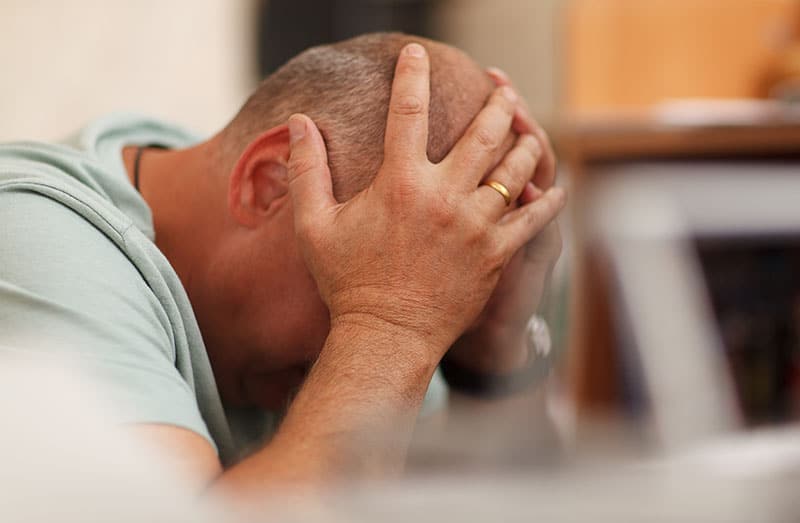What is Diffuse Thinning?
That’s a very common question. And we hear it pretty frequently. Diffuse thinning of the hair is not a type of hair loss per se. More accurately, it’s a term that’s used to describe the appearance of someone’s hair as a result of hair loss. There’s a lot more to diffuse hair loss than meets the eye. There can be many different factors that contribute to it. Thus, there is no one size fits all solution. Let’s break down some of the root causes of diffuse thinning. We’ll discuss how to recognize them and what to do about it.
What are some of the signs of diffuse thinning? Diffuse hair loss is a decrease in hair density across the entire scalp. This is different from male pattern baldness. After all, that either starts at the crown or recedes from the hairline, making a horseshoe shape. You may first observe diffuse hair thinning by noticing that you have a wider part in the hair. Additionally, you might notice thinner braids or ponytails, or you see more scalp after a haircut.

There are two different expressions of diffuse thinning. The first entails a thinning of each individual strand of hair, also known as hair follicle miniaturization. Because each strand is thinner, it gives an overall appearance of thinness. This can also contribute to increased breakage of the hair, and a less lustrous texture. The second is an increased amount of hair shedding. If our hair is shedding faster than it is regrowing, this will affect hair density over time. The first place you notice this may be in your comb, or shower drain. Frequently, you’ll notice diffuse thinning on the crown of the head as well.
What Causes Diffuse Thinning?
So now that we know what diffuse thinning is, what are some of the root causes? One common cause is telogen effluvium. This occurs when an unusually large number of hair follicles enter the telogen phase, otherwise known as the resting period in the hair growth cycle. When a person is going through periods of extreme stress there is an increased risk of the hair follicles entering this phase prematurely. As a result, this leads to a noticeable loss of hair density. Some of these high-stress situations can include a high fever, surgery, an accident, childbirth, and grief. As much as 70% of an individual’s hair follicles could enter the telogen phase early. For most hair loss sufferers, this relates to the severity of the stress in one’s life. Stress is more than an emotional state. It can trigger an immunological response that affects the entire body.
Hormones
Diffuse thinning can also be caused by hormonal imbalances. They may be related to polycystic ovarian syndrome or menopause in women. PCOS is a common hormone disorder that can cause a range of symptoms including excess facial and body hair. Ironically while PCOS can cause thicker hair on the face and body, some women experience thinning hair on their heads. Research suggests that hair loss during menopause is due to the body’s lowered production of estrogen and progesterone. When these hormones slow down so does hair growth, and over time the hair can appear thinner.
A decrease in progesterone and estrogen increases the production of androgens. This group of male hormones is responsible for shrinking the hair follicles, contributing to hair loss from the head. At the same time, they contribute to increased hair growth on the face. Consequently, some women may experience a peach fuzz appearance on their cheeks or grow hairs on their chin. Furthermore, this may occur even while they are experiencing hair loss.
Hormones aren’t the only factor that can contribute to diffuse loss. As we already covered, stress is a major factor, as is nutritional deficiency. Diagnostic blood tests can help rule out other causes such as conditions related to thyroid imbalance.
Health Conditions May Cause Hair Loss
Chronic health conditions can also contribute to diffuse thinning. It’s often observed alongside health issues such as hypothyroidism, hyperparathyroidism, gut dysbiosis, deficiencies or surpluses of nutrients, and heavy metal toxicity. The thyroid is a gland in the neck that plays a major role in several vital functions of the body. When the thyroid function begins to slow, less of the thyroid hormone is produced, resulting in chronic telogen effluvium. The thyroid hormone interacts with the hair follicle, assisting it in its ability to participate in stem cell function. This is why the follicle’s ability to produce a hair shaft is impacted. This could explain why many patients suffering from hypothyroidism also report experiencing hair loss in varying degrees of severity.
Hyperparathyroidism can also contribute to telogen effluvium. The parathyroid is located near the thyroid and is responsible for secreting a hormone that is known as the parathyroid hormone. Its main role is to regulate the levels of calcium in the body, but it also has the power to impact the hair growth cycle. If the parathyroid hormone binds to the parathyroid receptors in the hair follicle, hair growth is inhibited. Needless to say, if there is too much parathyroid hormone, a chronic condition known as hyperparathyroidism can occur. This can contribute to diffuse hair loss.
Nutrient Imbalances
Nutrient imbalances can be another cause of hair loss. In general, they will boil down to imbalances between a changed demand for certain nutrients in the body versus a changed supply of nutrients available in the body. For example, in acute telogen effluvium, a sudden loss of hair all at once, these nutrient imbalances can usually be attributed to poor dietary choices. If the condition is chronic telogen effluvium, excessive shedding that has been occurring for longer than six months continually, then these imbalances are usually the result of an underlying condition. Some common culprits include malabsorption and gut problems. Additionally, copper IUDs can cause problems. Finally, chronic illnesses which can increase the body’s demand for nutrients may result in hair loss. Blood tests are a way for you to rule out whether nutritional imbalances are contributing to your diffuse thinning.
Another cause of diffuse thinning that sometimes gets overlooked is heavy metal toxicity. Heavy metals such as lead, cadmium, thallium, mercury, arsenic, aluminum, and copper can be toxic at varying levels of exposure. Many of these heavy metals contribute to hair, the mechanisms of which differ from one to the other. For example, mercury and thallium disrupt the proliferation of the hair follicle. How? They bind to proteins that build the hair shaft. Mercury has also been known to contribute to the deregulation of the production of thyroid hormone. As a result, you may experience hypothyroidism.
Heavy Metal Toxicity
Heavy metals can also disrupt the natural hair growth cycle by displacing essential minerals such as magnesium, calcium, zinc, and iron. The essential minerals can get knocked out of their binding sites by heavy metals. This interrupts the important roles that essential minerals play in cellular activity. This can cause symptoms that mimic a nutrient deficiency.
If you’re confident that you are getting adequate nutrition that includes the recommended daily value of these essential minerals in your diet and you are not seeing any changes then it might be time to test for heavy metal exposure. The problem may be that the nutrients are not being properly transported to the tissues the way they should. Finally, if you live in a big city, getting tested for heavy metal toxicity can be helpful. Exposure to manufacturing facilities can also lead to heavy metal toxicity.
Treating & Preventing Diffuse Thinning of the Hair
Minoxidil
Now that we have some information about the causes of diffuse hair loss, what can we do to treat it? Minoxidil often known by its over-the-counter name Rogaine is a topical solution that is used to treat chronic hair loss. Originally developed as a treatment for hypertension, clinical trials revealed the surprising side effect was excessive hair growth. This drug was later developed into a topical formula in order to treat thinning hair. It is believed that Minoxidil’s actions as a vasodilator combined with its ability to upregulate certain growth factors are the reason why it is so effective as a hair loss treatment.
Keep in mind. Minoxidil cannot revive hair follicles that have died. Consequently, it cannot reverse balding. However, it has been shown to improve hair density and prevent further hair loss. Unfortunately, any hair growth you experience from Minoxidil will cease as soon as you stop taking it.
Finasteride
Another drug that is commonly used to treat hair loss is finasteride, otherwise known by its brand name Propecia. Finasteride is an oral prescription drug that was initially developed to treat Benign Prostatic Hyperplasia. Just as with Minoxidil, the drug triggered increased hair growth in trial participants. Finasteride inhibits the activities of 5AR, an enzyme that is responsible for the conversion of testosterone to DHT. This reduces the inflammation that contributes to follicle miniaturization, a major contributor to diffuse thinning. For women, this may help treat diffuse thinning if the issue is related to overproduction of DHT.
For men, finasteride may interfere with the ability to maintain an erection in some patients. So that is something to be aware of. Additionally, just like minoxidil, any hair loss gained while taking finasteride will be lost if you stop taking this medication. In other words, it’s a lifetime commitment. But then again, so is brushing your teeth.
Hair Transplantation
Follicular Unit Extraction (FUE) is a hair transplantation method that can address diffuse thinning. Healthy hair follicles are extracted from the back of the head where the hair tends to be thinner, and then the harvest grafts are transplanted into the thinning areas of the scalp. This procedure is permanent, minimally invasive, and allows patients to regrow their own natural hair. Not all women are a good fit for this procedure, however. If too many of the follicles are impacted by DHT then they will continue to miniaturize after transplantation. Other disadvantages to this method of treatment are that it is expensive (when compared to short-term methods. Finally, the hair around the donor sites must be shaved. In other words, if you like to wear your hair long, this may be a drawback or a deal-breaker.
At Home Solutions That May Lessen Diffuse Thinning
There are also some at-home procedures you can do to stimulate hair growth that doesn’t require medication and are less invasive than surgery. Low-Level Laser Hair Therapy (LLLT) laser caps like the Capillus RX 312 have been shown to be a pain-free way to increase hair growth and density. These laser caps can be comfortably worn under a baseball cap. Furthermore, a lasercap like Capillus only requires 6 minutes of daily use to see results. At Best Hair Transplant we offer our patients the Capillus RX 312 the most powerful laser cap available anywhere in the world. It has been clinically studied and shown to prevent further hair loss, and can not only improve hair density but the health of the hair follicle itself. You can find out more info about Capillus RX312 at Laser Cap Me.
Another in-home treatment option is microneedling. Also known as Collagen Induction Therapy (CIT), microneedling involves the use of facial tools, like derma rollers and derma stamps that contain tiny needles which puncture the scalp. This practice may sound counterintuitive at first read. Medical research says otherwise. Microneedling works by inducing collagen production, increasing cutaneous blood flow, which is essential to the growth of healthy hair. A 2013 study revealed that microneedling could increase the effects of minoxidil. For most people, a once-weekly microneedling treatment would be sufficient.
Scalp Massage
Scalp massage is a gentler home treatment that you can also employ. Looking to increase blood flow to the scalp? Aromatic oils such as peppermint, rosemary, and cinnamon may help your hair. Additionally, they may stimulate the hair follicles. They also have anti-inflammatory, anti-fungal, and antimicrobial action so they are helpful in addressing any imbalances that may be happening on the surface of the scalp.
Use a few drops of one or more of these essential oils with a carrier oil. Pumpkin seed or avocado oil are great choices to massage into the scalp. The phytosterols in pumpkin seed oil could help to block the enzymes and hormones in the scalp that contribute to hair loss. Scalp massage stimulates blood flow and strengthens the hair follicles by stretching the dermal paella, this can lessen mechanical stress which can be a contributing factor in hair loss. Daily scalp massage can also be a helpful way to reduce stress and tension.
As you can see diffuse hair loss can occur as a result of many different causes. The first step is looking deeper at the root causes. In doing so, we can eliminate any imbalances or serious health issues that could be contributing to this issue. The good news is that there are many effective treatment options to choose between in order to prevent further hair loss and regrow hair. Diffuse hair loss can be frustrating but thankfully there are many solutions.
SUFFERING FROM DIFFUSE THINNING HAIR LOSS?
Best Hair Transplant is the best place to schedule your hair transplant in Los Angeles. We’ve helped both men and women regrow their lost hair. But don’t take our word for it. We suggest learning as much as possible about hair restoration. Do so prior to making a decision on how to address your hair loss. Not every procedure is right for everyone.
At Best Hair Transplant, we’re proud of our results and happy to provide hair restoration services. Additionally, we’re proud to make hair transplants affordable and help you save money on a variety of hair transplants.
To ensure your ease of mind, you can view our customer recommendations HERE. Furthermore, you can also see our Google reviews and Yelp reviews. We can’t wait to help you start restoring your lost hair.
YOUR HAIR RESTORATION SOLUTION
Best Hair Transplant
1970 S. Prospect Ave., Suite 2
Redondo Beach, CA 90277
(213) 403-0455
References:
- https://www.birminghamdermatologyclinic.co.uk/blog/what-is-diffuse-thinning-and-what-can-be-done-to-prevent-it/
- https://www.hairguard.com/diffuse-thinning/
- https://www.healthline.com/health/menopause/hair-loss
- https://www.24mantra.com/blogs/organic-lifestyle/how-to-use-cinnamon-oil-for-fighting-hair-loss/#:~:text=A%20healthy%20scalp%20enhances%20the,promote%20healthy%20hair%20and%20scalp.
- https://www.healthline.com/health/pumpkin-oil-for-hair#research











